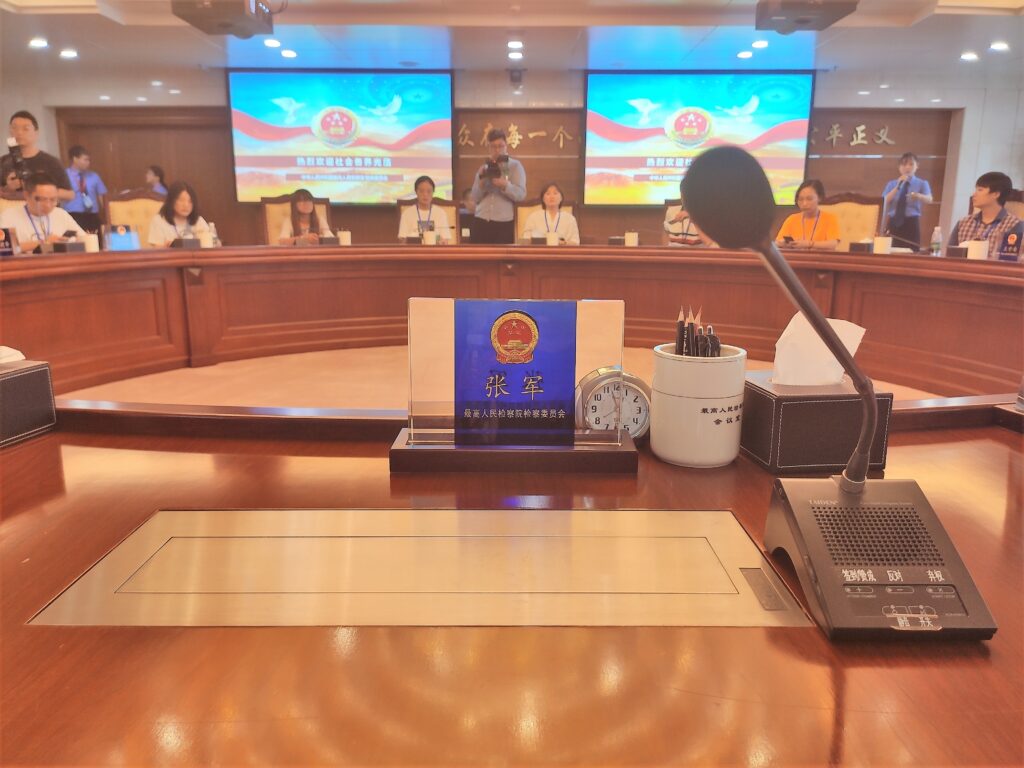A new paper by Peter Chi Han Chan and Wanqiang Aiden Wu

In 2020, China’s Supreme People’s Procuratorate (SPP) initiated a transformative reform in the performance evaluation of prosecutors that promises to reshape the legal landscape significantly. For decades, Chinese prosecutors were assessed mainly on the volume of cases they handled by their department leaders, also known as the “Line Appraisal” model. This approach emphasized quantitative metrics, like conviction rates and case closure speed, sometimes even at the expense of thoroughness and the quality of justice. The result was a prosecution system that tended to prioritize quantity over quality, raising concerns about fairness and the effectiveness of the legal process.
Recognizing these limitations, the SPP launched the performance evaluation reform of “Case-Process Ratio 案-件比”. This innovative approach shifts the focus from sheer numbers to a more nuanced evaluation of the prosecutorial process, aiming to reduce unnecessary procedures and improve the overall efficiency and quality of case handling. The “Case-Process Ratio” measures the balance between the number of cases and the procedural steps required, with an ideal ratio indicating that each case is handled with minimal yet sufficient procedural actions to ensure justice.
The “Case-Process Ratio” model introduces several key improvements to the prosecutorial system. By focusing on reducing unnecessary procedures, it encourages prosecutors to streamline their case management, saving time and resources. This change is expected to enhance the efficiency of legal proceedings and reduce the burden on all parties involved. Additionally, by incorporating the perceptions of the involved parties into the evaluation process, the model emphasizes the importance of public trust in the legal system—a crucial factor in maintaining social stability and the rule of law.
This new model deviates from the traditional result-oriented approach of the “Line Appraisal” model, which focuses mainly on departmental indicators such as conviction rate of the prosecution department and arrest rate of the arrest department. Drawing upon two universal experiences, the “Case-Process Ratio” pioneers a more holistic assessment, taking into account parties’ perceptions of the prosecution process and underscoring the socio-political implications of prosecutorial conduct. This is also an ambitious move for the SPP to gradually evolve from being a mere crime controller to a “social governor”, who clearly enjoys a more integrated jurisdiction and a wider reach in terms of institutional power.
This reform is more than a technical adjustment; it reflects a broader transformation in the role of Chinese prosecutors. Historically, prosecutors in China were seen primarily as crime controllers, focusing on conviction rates and the supervision of legal processes to maintain social order. However, the SPP’s new evaluation model is part of a broader set of reforms aimed at transforming prosecutors into “social governors”—figures who not only enforce the law but also contribute to the governance and well-being of society. This expanded role requires prosecutors to consider the broader social impact of their actions, manage cases in a way that is more attentive to the personal experiences of those under their jurisdiction, and ensure that the legal process is perceived as fair and just by the public.
However, the new model is not without its challenges. One of the most significant concerns is that while the “Case-Process Ratio” model aims to improve procedural quality, it may still inadvertently reinforce the prosecutor’s traditional role as a crime controller. For instance, the traditional metric of case closure speed has not been eliminated and remains one of the core indicators in the overall evaluation system, albeit less emphasized than before, prosecutors may still feel pressured to close cases quickly, potentially prioritizing speed over quality. The procedural controls introduced by the new model, while designed to ensure fairness and efficiency, could also limit prosecutors’ flexibility, forcing them to adhere to strict guidelines that may not always suit the nuances of individual cases.
On the whole, the “Case-Process Ratio” model is part of a larger wave of legal reforms in China, designed to modernize the prosecutorial system and align it with broader goals of national governance. These reforms include the integration of arrest approval and prosecution powers, the introduction of the plea leniency system, and efforts to enhance the standardization of legal processes. Together, these changes aim to create a more cohesive and effective legal system that can better respond to societal needs.
As China’s legal system continues to evolve, the “Case-Process Ratio” model represents a significant step forward in the quest for a more efficient, just, and socially responsive prosecutorial system. Its success will depend on how well it can balance the need for procedural integrity with the broader goals of legal and social governance. The shift from a caseload-driven model to one that prioritizes procedural quality marks a turning point in the role of prosecutors in China. It signals a move towards a more holistic approach to justice—one that recognizes the importance of fairness, efficiency, and public trust in the legal system. As this reform unfolds, it will undoubtedly serve as a valuable case study for legal systems worldwide, offering insights into the challenges and opportunities of modernizing prosecutorial practices in a rapidly changing society.
The paper From “Line Appraisal” to “Case-Process Ratio”: Will the New Case Quality Assessment System Facilitate the Changing Role of Chinese Prosecutor? was published in the Hong Kong Law Journal. A free draft is uploaded to SSRN.
Peter C. H. Chan is Associate Professor at the City University of Hong Kong, School of Law where he also serves as the Associate Programme Director of LLMArbDR programme. His publications and contact information can be found on SSRN.
Wanqiang Wu is a PhD candidate at Shanghai Jiao Tong University who is entering the academic job market and is open to employment opportunities. His research focuses on China’s criminal justice system, employing empirical research methods and socio-legal analysis. His publications and contact information can be found on Google Scholar.

